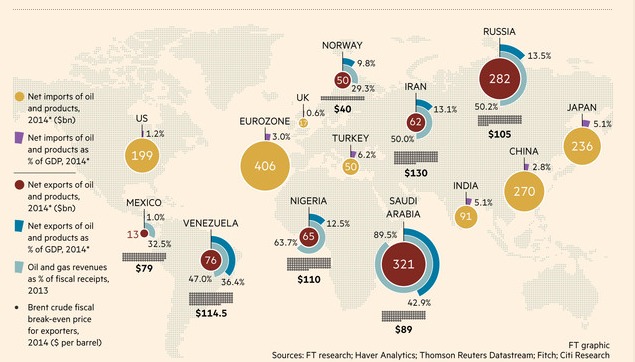Oil prices, now testing five-year lows, have plummeted 20% over the last month.
Small wonder, investors are scrambling to get their minds around the implications for the world economy and their own portfolios.
It’s hard to know how much lower prices might go now that key benchmarks are below the $60 per barrel range.
However, global energy demand is weak, given the slowdown in the Eurozone, China and Japan.

On the supply side, OPEC and U.S. shale producers continue to maintain high production rates. It’s hard to see a price rebound anytime soon.
Here are five ways to fortify your portfolio during these turbulent times in the energy market.
Russian Exposure
Vladimir Putin’s petro state is getting hit by a double whammy of low oil prices and Western sanctions over its actions in Ukraine.
The ruble is in a free fall and the economy is expected to fall into a recession in 2015.
If you own Russian-focused ETFs, you may want to rethink your strategy.
Also, take a hard look at companies with big exposures to the Russian market.
Citibank recently compiled this list of corporates with substantial sales in Russia. They included Carlsberg (CABJF), BASF (BASFY) and Danone (DANOY).
Airlines
So much for defense.
You may also want to consider stocking up on companies that will benefit from the oil price swoon.
At the top of the list are air carriers.
The industry’s fuel bill could drop by $10 billion, according to an estimate at Barclays cited by the Financial Times.
The investment bank sees fuel savings powering airline earnings in 2015.
Not surprisingly, the stocks of American Airlines (AIR), United (UAL) and Delta (DAL) have surged since mid-October in tandem with oil price declines.
Trucks
And don’t forget trucking lines.
Zacks Investment research recently cited truckers as a big beneficiary of the oil price swing.
The research firm recommended looking at Old Dominion Freight Line (ODFL), Knight Transportation (KNX) and Celadon Group (CGI) as anti-oil proxy plays.
Consumer stocks
Other sectors worth a serious look include retailers and drug store chains.
Consumers are paying less to fill up their car tanks and will have more disposable income that’s starting to show up in the retail data.
Since mid-October, the Standard & Poor’s 500 Food and Staples Retailing Index has outperformed the broader market.
That’s great news for stocks such as Wal-Mart (WMT), Kroger Co. (KR), CVS Health Corp. (CVS) and other merchants that focus on day-to-day household items.
Emerging markets
In my opinion, the U.S. is now a major player in exploration and rifinery of oil. It’s still debatable how positive lower energy prices are for the U.S. economy.
However, this shift in energy prices could be good news for emerging market economies that rely on oil imports.
The FT recently published this useful chart showing the winners and losers.

India, China and Turkey seem sure to get an economic boost as their national energy bills lessen.
Takeaway
It looks like the oil market could be stuck in low gear well into 2016, according to this analysis of the oil futures market by HCB Investment Management, which oversees the Covestor Tactical Energy portfolio.
If that’s the case, it may make sense to reach out to your investment advisor, or check out online sites with a deep offering of investment vehicles, and look for ways to fortify your portfolio against a very volatile energy market.
This could be a long and bumpy ride for investors.
DISCLAIMER: The investments discussed are held in client accounts as of November 30, 2014. These investments may or may not be currently held in client accounts. The reader should not assume that any investments identified were or will be profitable or that any investment recommendations or investment decisions we make in the future will be profitable. Past performance is no guarantee of future results.



